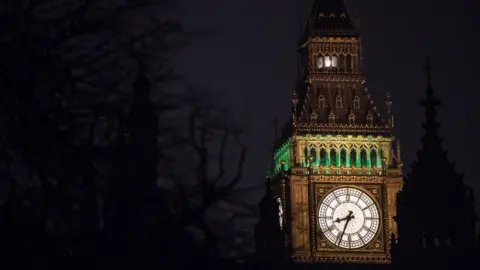On a recent occasion, the historic Ayrton Light atop Big Ben was illuminated in a poignant ceremony to mark the 80th anniversary of its original activation during World War II. This momentous event was presided over by House of Commons Speaker, Sir Lindsay Hoyle, who acknowledged the significance of the light in representing hope and resilience during a tumultuous period in British history.
The Ayrton Light, which is perched above the iconic clock face of the Elizabeth Tower—often colloquially referred to as Big Ben—had originally been extinguished at the onset of the war in 1939. This action was in compliance with blackout regulations that were designed to minimize visible light, thereby preventing German bombers from identifying their targets during air raids. The light remained off throughout the war, only to be turned back on in May of 1945 by then Commons Speaker Colonel Clifton Brown, who interrupted parliamentary proceedings to announce its reactivation after a period of five years, seven months, and 23 days of darkness.
On this occasion, Sir Lindsay Hoyle’s act of switching on the Ayrton Light was more than just a ritual; it was a ceremonial acknowledgment of the resolve of the British people. Addressing the members in attendance, Clifton Brown had expressed his desire for the light to symbolize not only the gathering of Parliament but also to shine as a beacon of hope in a “sadly torn and distracted world.” Ultimately, the Ayrton Light serves a practical purpose as well, signifying that one of the two Houses of Parliament—either the House of Commons or the House of Lords—was in session.
The gathering on this anniversary included two notable Chelsea Pensioners: John Morris, aged 103, and Tony Hunt, aged 85. They shared their personal recollections of Victory in Europe (VE) Day, a moment when the confining darkness of war was lifted in favor of joy and celebration. Mr. Hunt reflected on his memories as a child during VE Day, recounting how swiftly things changed from abiding by blackout regulations to living in a newfound freedom with the lifting of restrictions, allowing for street parties and gatherings that reconnected families separated by the war.
Sir Lindsay noted how significant it was to recreate such a symbolic moment in British history alongside these two veterans, who bore witness to the struggles of war and feelings of jubilation upon its conclusion. The Ayrton Light, named after Acton Smee Ayrton, who served as Commissioner of Works in the 19th century, was originally installed in 1885 at the behest of Queen Victoria. She wanted a way to see if the Parliament was in session from Buckingham Palace after dark.
The light was unfortunately turned off in 2017 for repairs, marking the first such cessation since World War II, but it was meticulously restored in a workshop based in Sheffield and re-illuminated in 2022.
In the broader context, the reactivation of the Ayrton Light serves not merely as a nostalgic reminder of past trials but as a renewed commitment to democratic values and the spirit of resilience characteristic of the British people. By commemorating such moments, the ceremony reinstates the light’s role as a harbinger of hope and a symbol of parliamentary democracy, cherished by both current generations and those who endured the sacrifices of wartime Britain.



